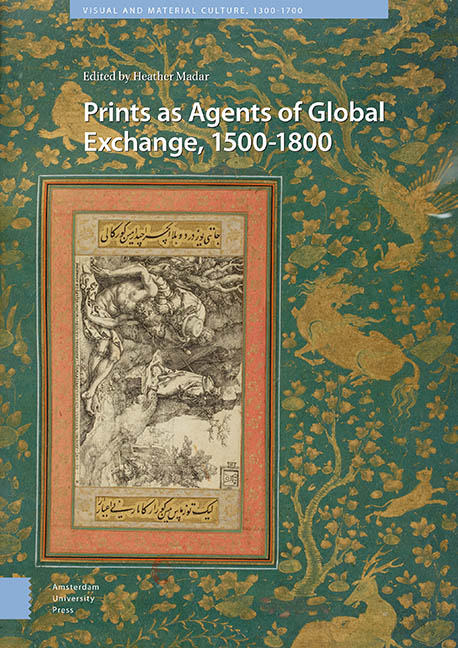Book contents
- Frontmatter
- Table of Contents
- List of illustrations
- Introduction
- 1 Concealing and Revealing the Female Body in European Prints and Mughal Paintings
- 2 The Sultan’s Face Looks East and West: European Prints and Ottoman Sultan Portraiture
- 3 From Europe to Persia and Back Again: Border-Crossing Prints and the Asymmetries of Early Modern Cultural Encounter
- 4 The Dissemination of Western European Prints Eastward: The Armenian Case
- 5 The Catholic Reformation and Japanese Hidden Christians: Books as Historical Ties
- 6 (Re)framing the Virgin of Guadalupe: The Concurrence of Early Modern Prints and Colonial Devotions in Creating the Virgin
- 7 Hidden Resemblances: Re-contextualized and Re-framed: Diego de Valadés’ Cross Cultural Exchange
- 8 The Practice of Art: Auxiliary Plastic Models and Prints in Italy, Spain, and Peru
- 9 Ink and Feathers: Prints, Printed Books, and Mexican Featherwork
- Index
Introduction
Published online by Cambridge University Press: 16 December 2021
- Frontmatter
- Table of Contents
- List of illustrations
- Introduction
- 1 Concealing and Revealing the Female Body in European Prints and Mughal Paintings
- 2 The Sultan’s Face Looks East and West: European Prints and Ottoman Sultan Portraiture
- 3 From Europe to Persia and Back Again: Border-Crossing Prints and the Asymmetries of Early Modern Cultural Encounter
- 4 The Dissemination of Western European Prints Eastward: The Armenian Case
- 5 The Catholic Reformation and Japanese Hidden Christians: Books as Historical Ties
- 6 (Re)framing the Virgin of Guadalupe: The Concurrence of Early Modern Prints and Colonial Devotions in Creating the Virgin
- 7 Hidden Resemblances: Re-contextualized and Re-framed: Diego de Valadés’ Cross Cultural Exchange
- 8 The Practice of Art: Auxiliary Plastic Models and Prints in Italy, Spain, and Peru
- 9 Ink and Feathers: Prints, Printed Books, and Mexican Featherwork
- Index
Summary
Abstract
Printed works were disseminated beyond the borders of Europe, beginning to move globally shortly after the invention of the Gutenberg press. Brought by missionaries, artists, merchants, diplomats and travelers for motivations including conversion, artistic curiosity and trade, European prints traveled to areas as varied as Turkey, India, Iran, Ethiopia, China, Japan and the Americas. Printed works became important sources of cultural knowledge and sites of inter-cultural dialogue. Analysis of these transmissions raise numerous issues: the agency and motivations of actors on either side; ways European prints were recontextualized and transformed to provide locally specific meanings; aesthetic responses to European prints in global contexts. Analysis of these issues in turn leads to methodological challenges and a reconsideration of previous approaches.
Keywords: transculturalism, cross-cultural exchange, Renaissance print circulation, global Renaissance
That printmaking's ease of replication and comparatively inexpensive nature facilitated the widespread dissemination of printed works within Europe during the early modern period is common knowledge. The significance of what can be understood as the media, communications and even epistemological revolution occasioned by printmaking has been recognized as profound, with printmaking posited as a decisive agent in phenomena ranging from the Protestant Reformation to the Scientific Revolution. Less a part of the standard narrative of printmaking's significance is a recognition of the frequency with which the dissemination of printed works also occurred beyond the borders of Europe and a consideration of the impact of this broader movement of printed objects. Within a decade of the invention of the Gutenberg press, European prints began to move globally. Over the course of the fifteenth to the eighteenth centuries, the time frame considered in this collection of essays, numerous prints produced in Europe traveled to areas as varied as Turkey, India, Iran, Ethiopia, China, Japan and the Americas, where they were taken by missionaries, artists, travelers, merchants and diplomats. The means and motivations for this cross-cultural migration of printed media were many, and varied in terms of the dynamics of the cultural exchanges and the primary mode of transmission. These disseminations were frequently ideologically charged, with prints used particularly as essential tools in conversion efforts by Christian missionaries and for didactic purposes.
- Type
- Chapter
- Information
- Prints as Agents of Global Exchange, 1500-18001500-1800, pp. 17 - 30Publisher: Amsterdam University PressPrint publication year: 2021

